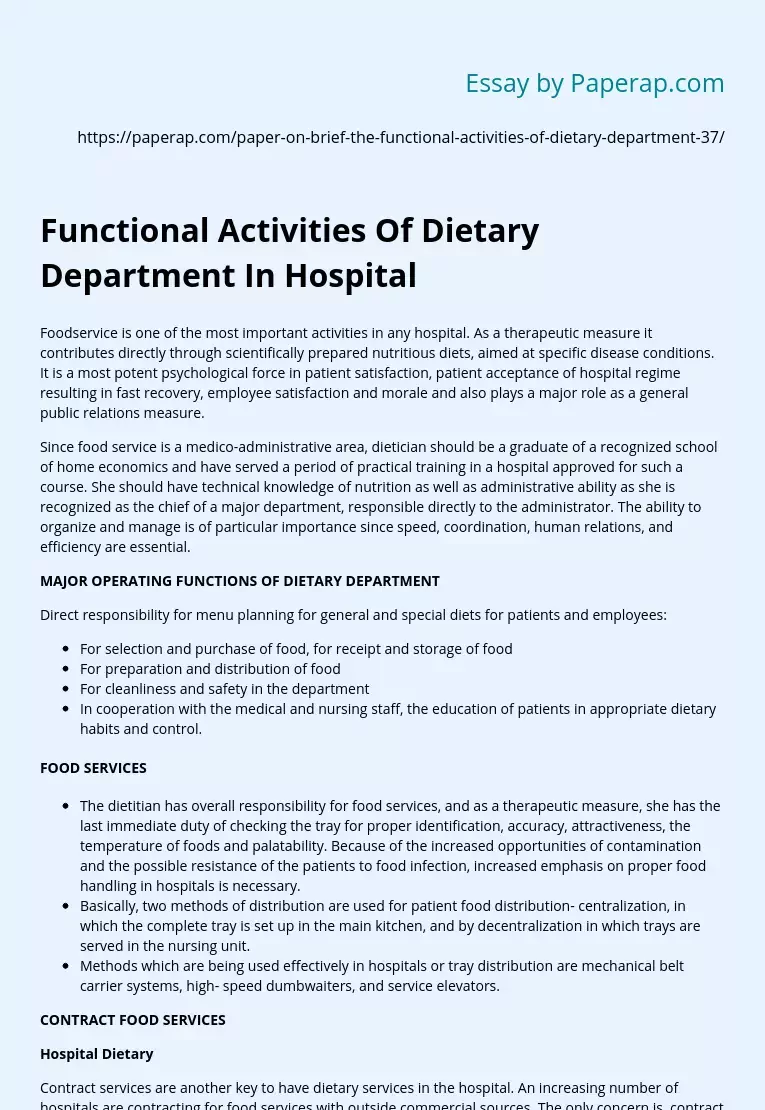Functional Activities Of Dietary Department In Hospital
Foodservice is one of the most important activities in any hospital. As a therapeutic measure it contributes directly through scientifically prepared nutritious diets, aimed at specific disease conditions. It is a most potent psychological force in patient satisfaction, patient acceptance of hospital regime resulting in fast recovery, employee satisfaction and morale and also plays a major role as a general public relations measure.
Since food service is a medico-administrative area, dietician should be a graduate of a recognized school of home economics and have served a period of practical training in a hospital approved for such a course.
She should have technical knowledge of nutrition as well as administrative ability as she is recognized as the chief of a major department, responsible directly to the administrator. The ability to organize and manage is of particular importance since speed, coordination, human relations, and efficiency are essential.
MAJOR OPERATING FUNCTIONS OF DIETARY DEPARTMENT
Direct responsibility for menu planning for general and special diets for patients and employees:
- For selection and purchase of food, for receipt and storage of food
- For preparation and distribution of food
- For cleanliness and safety in the department
- In cooperation with the medical and nursing staff, the education of patients in appropriate dietary habits and control.
FOOD SERVICES
- The dietitian has overall responsibility for food services, and as a therapeutic measure, she has the last immediate duty of checking the tray for proper identification, accuracy, attractiveness, the temperature of foods and palatability. Because of the increased opportunities of contamination and the possible resistance of the patients to food infection, increased emphasis on proper food handling in hospitals is necessary.
- Basically, two methods of distribution are used for patient food distribution- centralization, in which the complete tray is set up in the main kitchen, and by decentralization in which trays are served in the nursing unit.
- Methods which are being used effectively in hospitals or tray distribution are mechanical belt carrier systems, high- speed dumbwaiters, and service elevators.
CONTRACT FOOD SERVICES
Hospital Dietary
Contract services are another key to have dietary services in the hospital. An increasing number of hospitals are contracting for food services with outside commercial sources. The only concern is, contract food services like any other service as both the possibilities of results being reported as excellent to most unsatisfactory.
Hospital dietetic services should be under the direction of a qualified manager, preferably a professionally trained dietician. As with any type of dietary organization, constant liaison with the medical staff should be maintained. The plan, program, organization, and relationships should be in writing and reviewed periodically. Some of the responsibilities of the contractor cover all appropriate activities such as nutritional standards, individual patient contract, patient education, systematic employee training and adequate supervision.
In 1962, the American Hospital Assocation and the American Dietetic Association approved guiding principles for contractual services, some of the highlights of which include:
1. Hospital dietwtic services should be under the direction of a qualified manager, preferably a professionally trained dietitian.
2. As the head of a major department, reporting directly to the appropriate hospital administrative authority, functions, responsibilities, and relationships should be fully documented and clearly understood.
3. As with any dietary organization, constant liaison with the medical staff should be maintained.
4. The plan, program, organization, and relationships should be in writing and reviewed periodically.
5. Responsibilities of the contractor cover all appropriate activities such as nutritional standards, individual patient contract, patient education, systematic employee training and adequate supervision, quality food procurement, sanitation and maintenance, appropriate records and reports.
MENUS
Preparation of menus is the immediate responsibility of the dietician and must be undertaken in the light of clinical; requirements, economy and practical management procedures. A successful modification is accomplished through daily visits to patients by the dietitian. This is the most important psychological and public relations gesture to the patient and is of real value to the dietitian for economy purposes, improvement of services and forestalling complaints. The Master Menu Service, published monthly in Hospitals, is an excellent guide and time saver if properly adapted to local needs.
FOOD PURCHASING
Since the dietitian plans the menus, the selection standards, purchasing, and scheduling for delivery of food items must be her immediate responsibility unless there is a food manager.
PROCEDURES FOR EFFECTICE CONTROL:
1. To maintain accurate inventory of all the items of the department.
2. To maintain record of all purchase made, particularly of the quality and quantity of food.
3. All bills must be checked against the quotations.
4. The standard system of purchasing so that a written requisition is ready for purchase.
5. Where more than one kitchen or pantry for servicing is maintained, any transfer of equipment between two areas must be recorded in the ledger of the respective areas.
6. Specifications laid down or established for purchases.
7. Accurate records of the meals served per shift.
8. A record of fuel cost and requirements as well as the supply of disposable items like dusters, brooms etc.
9. A personal record and their salaries including the cost of uniforms, provident fund, leave etc.
10. Last but not the least a daily report to the administrator by the department should be instituted.
Sanitation Practices, personnel, and physical facilities from food services offer some of the greatest sanitation problems and hazards with which a hospital is faced. In addition to training, periodic inspection of the entire dietary department must be maintained, to include floors, walls, ceilings, utensils, machinery and equipment, cabinets, sinks, plumbing and grease traps and employees restrooms and washrooms.
DISHWASHING
The dishwashing rooms should be physically separated from the food production and serving activities and from the cafeteria serving line and dining area.
Functional Activities Of Dietary Department In Hospital. (2019, Dec 05). Retrieved from https://paperap.com/paper-on-brief-the-functional-activities-of-dietary-department-37/

